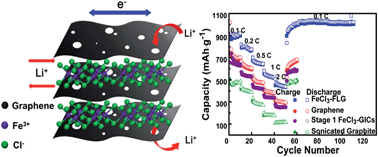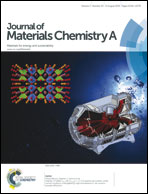FeCl3 intercalated few-layer graphene for high lithium-ion storage performance†
Abstract
We report a facile and efficient approach to prepare graphene and FeCl3-intercalated few-layer graphene (FeCl3-FLG) with stage 1 FeCl3-graphite intercalation compounds (GICs) as a precursor by a non-oxidation process. The enlarged interlayer spacing by the intercalation of FeCl3 greatly weakens the interaction among graphite sheets and thus facilitates the exfoliation of FeCl3-GICs. By ultrasonic treatment, FeCl3-GICs are well exfoliated to graphene sheets (<2 nm) with a high yield of 100%, while the ultrasonication of pristine graphite is less efficient with a low yield (about 32%) of graphene sheets. By simply controlling the sonication time, FeCl3-FLG consisting of graphene sheets and sandwiched FeCl3 is also prepared, which exhibits a high capacity of 989 mA h g−1 after 50 cycles, fairly higher than that of the sonicated graphite (503 mA h g−1) and the theoretical value of graphite (372 mA h g−1). Furthermore, FeCl3-FLG still retains a reversible capacity as high as 539 mA h g−1 even at a current density of 1000 mA g−1. Therefore, the high reversible capacity, remarkable cycling stability and superior capability make FeCl3-FLG promising as anode materials for large-scale and high-capacity lithium ion batteries.


 Please wait while we load your content...
Please wait while we load your content...